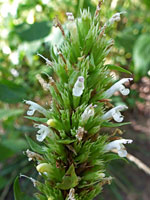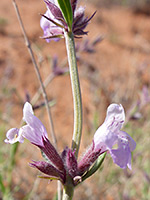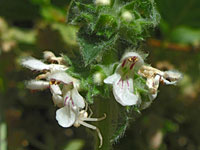Lamiaceae, the mint family, is one of the largest groupings of US wildflowers, with 570 species in 85 genera, found in all habitats and elevations. Plants are mostly herbs or (less often) small shrubs, producing upright stems, often grooved and/or square in cross-section, with flowers typically borne in a series of spherical or whorled clusters along the upper part of the stem, with distinct spaces (internodes) between them. The lamiaceae family contains many of the commonly used cooking herbs.
Individual flowers are bilaterally symmetric; they usually have a five-pointed calyx and a lobed corolla formed of five fused petals, typically grouped into an upper lip (often two-lobed) and a three-lobed lower lip. Some species have a corolla formed of just two petals. Stamens number two or four; some species have two stamens and two staminodes (infertile stamens). Leaves are whorled or in opposite pairs, either simple or lobed, often gland-dotted.
All Contents © Copyright The American Southwest | Comments and Questions | Contribute | Affiliate Marketing Disclosure | Site Map






































